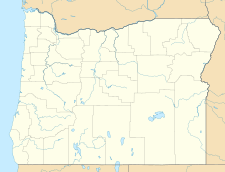Lewis Glacier (Oregon) facts for kids
Quick facts for kids Lewis Glacier |
|
|---|---|
| Type | Mountain glacier |
| Location | Cascade Range, Deschutes County, Oregon, U.S. |
| Coordinates | 44°05′42″N 121°46′00″W / 44.09500°N 121.76667°W |
| Length | 3,000 ft (910 m) |
| Terminus | Barren rock |
| Status | Retreating |
Lewis Glacier is a glacier located in the U.S. state of Oregon. It sits high up in the Cascade Range mountains, usually above 9,000 feet (2,743 meters) in elevation. This glacier is found on the southeast side of South Sister, which is a type of volcano called an inactive stratovolcano. An inactive stratovolcano is a tall, cone-shaped volcano that hasn't erupted in a long time but could still erupt in the future.
Lewis Glacier has been getting smaller since a period known as the Little Ice Age. This "Little Ice Age" was a time from about 1350 to 1850 AD when many parts of the world experienced cooler temperatures. During this cooler period, Lewis Glacier reached its largest size, stretching down to an elevation of about 6,447 feet (1,965 meters). However, since then, the glacier has been shrinking. In 2005, the end of the glacier, called its terminus, was found to be much higher, at about 8,790 feet (2,679 meters). This shows how much it has retreated.
Contents
What is a Glacier?
A glacier is a huge, slow-moving river of ice. It forms over many years as layers of snow pile up and get compressed into ice. Glaciers are found in places where snow falls but doesn't completely melt away in the summer. Over time, the weight of the snow and ice causes the bottom layers to turn into a dense, icy mass that slowly flows downhill due to gravity.
How Glaciers Form
Glaciers begin as snowflakes. When more snow falls in winter than melts in summer, it starts to build up. As new snow falls, it presses down on the old snow. This pressure, along with some melting and refreezing, changes the fluffy snow into a denser, granular ice called firn. If more firn accumulates, it eventually becomes solid glacial ice. This process can take many decades or even centuries.
Types of Glaciers
There are different kinds of glaciers. Lewis Glacier is a mountain glacier, also known as an alpine glacier. These glaciers form in high mountain valleys and flow down the slopes. Other types include ice sheets, which are massive glaciers that cover entire continents, like in Antarctica and Greenland.
Lewis Glacier's Location
Lewis Glacier is located in the central part of Oregon. It is specifically in Deschutes County, Oregon. The glacier is part of the beautiful and rugged Cascade Range, a major mountain range that stretches through western North America.
South Sister Mountain
The glacier sits on the slopes of South Sister. South Sister is one of three tall mountains known as the "Three Sisters." These mountains are popular for hiking and climbing. South Sister is the third-highest peak in Oregon. Even though it's an inactive volcano, it's still an important part of the landscape where Lewis Glacier exists.
Why Glaciers Retreat
When a glacier "retreats," it means the end of the glacier is moving backward, or uphill. This happens when the amount of ice melting or breaking off is greater than the amount of new snow and ice being added.
Causes of Retreat
Several factors can cause a glacier to retreat. The most common reason is a warming climate. As temperatures rise, more ice melts during the summer, and less snow might fall in the winter. This imbalance causes the glacier to shrink. Changes in precipitation patterns can also play a role. If there's less snowfall, the glacier doesn't get enough new ice to replace what's lost.
Impact of Retreating Glaciers
Retreating glaciers can have several impacts. They contribute to rising sea levels as the melted ice flows into oceans. They can also affect local water supplies, as many communities rely on glacial meltwater for drinking water and irrigation, especially in dry seasons. The shrinking of glaciers also changes mountain landscapes and can impact the plants and animals that live in those areas.


